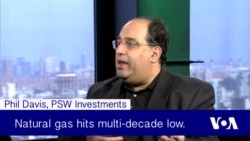In the past two weeks, natural gas prices have moved higher by 15 percent. The increase comes after Phil Davis of Phil’s Stock World told VOA that he believed that it was a good time to initiate new positions.
The factor depressing natural gas prices is over supply. In fact, prices hit an 18-year low on March 1, just as Davis was buying. Just like crude oil, natural gas production is historically high, which means storage levels are elevated since there is not enough demand to take some of the product out of the system. U.S. natural gas production has grown each year since 2006 due in part to the rapid growth from supply of shale resources.
“The reason we initiated positions in natural gas and the United States Natural Gas ETF, ticker symbol UNG was because the price in the commodity itself was too low and the selloff was overdone. Since then, natural gas has rallied 15 percent, and we believe it is in the correct trading range,” Davis said. “This also coincided with the beginning of Liquefied Natural Gas (LNG) that started at the end of March.”
The U.S. Department of Energy has approved projects that may send abroad as much as 283 million cubic meters per day of U.S. gas, and it is considering applications for an additional amount.
Davis believes that there will be upward pressure on natural gas for at least the next two years. He said, "We expect that natural gas prices will hit $2.50 by the end of 2016, and could see $3.00 in 2017 as the U.S. moves towards an equilibrium to the rest of the world with LNG exports.”
Analysts at Morgan Stanley expect natural gas prices to be somewhat supported. In a research note analysts said, “Last week we focused on northeast production, which has seen a cave of curtailments month-to-date, but the remaining U.S. supply regions have also shown declines, which should help provide some level of support despite bearish storage.”








